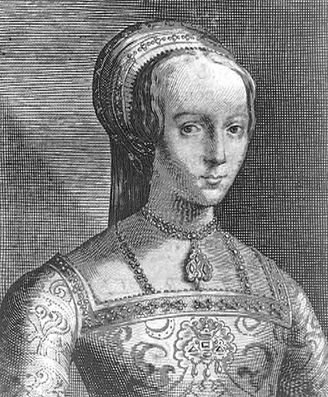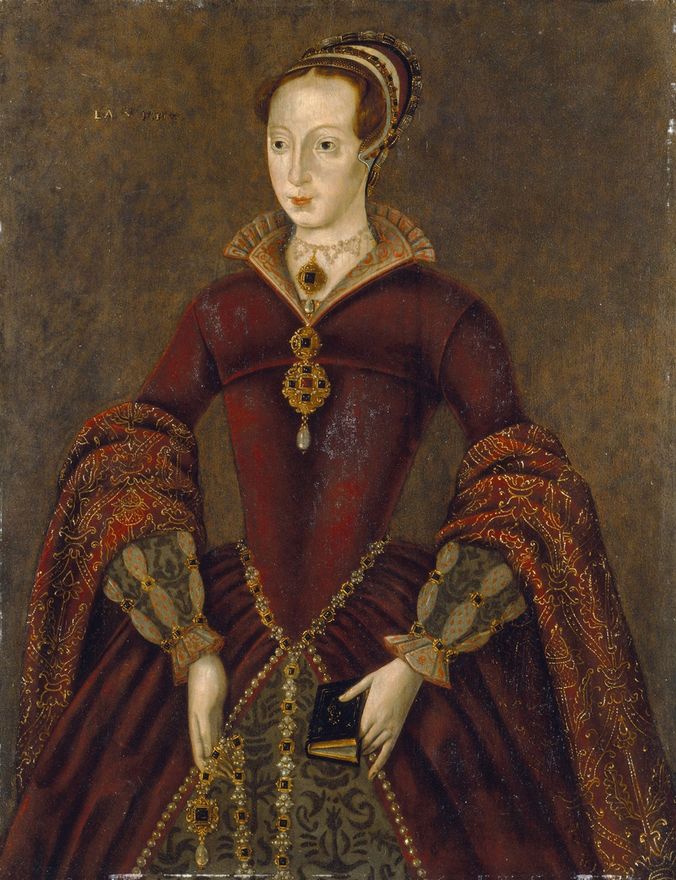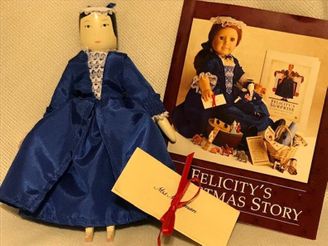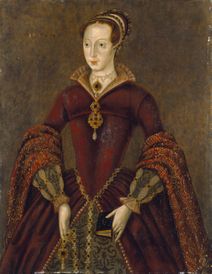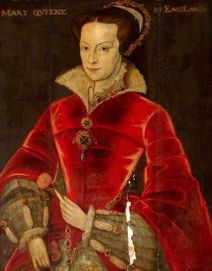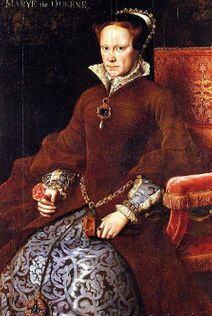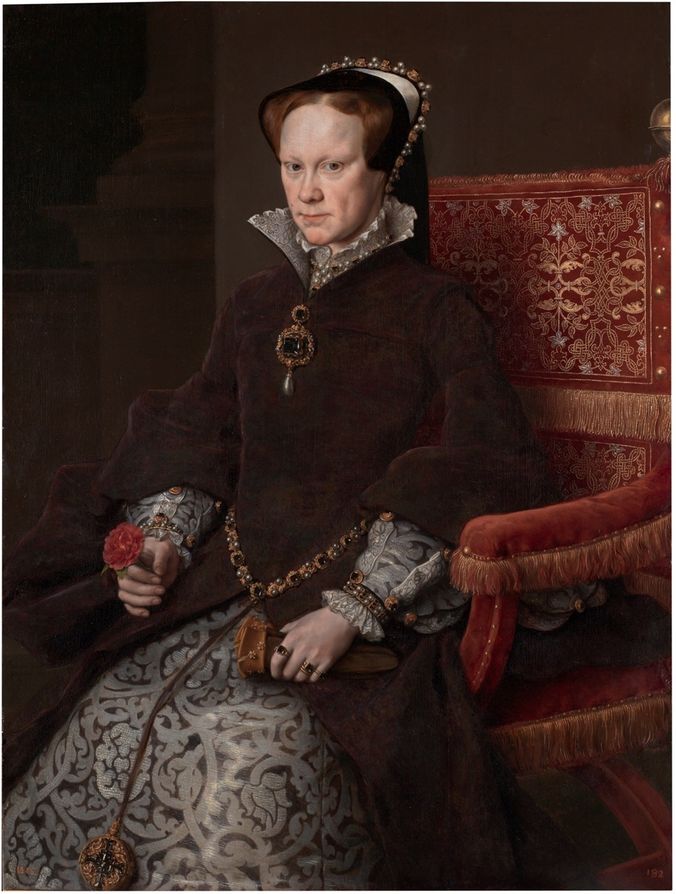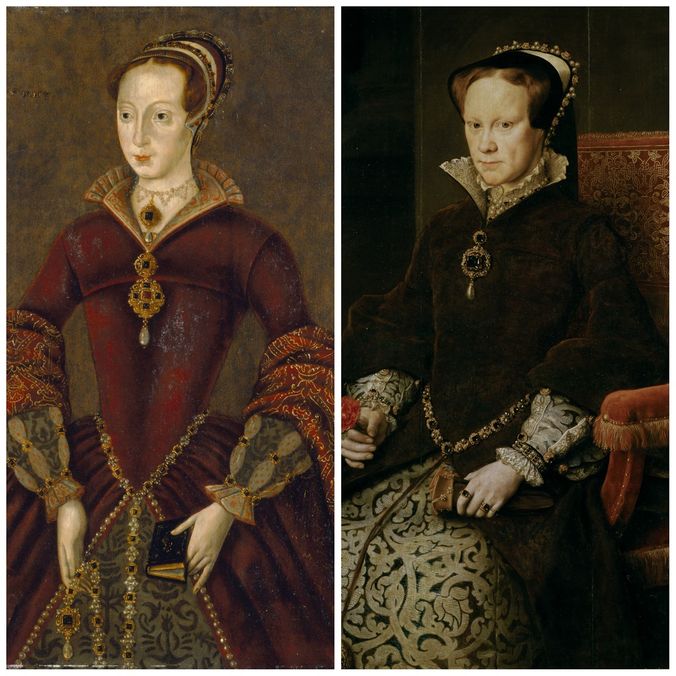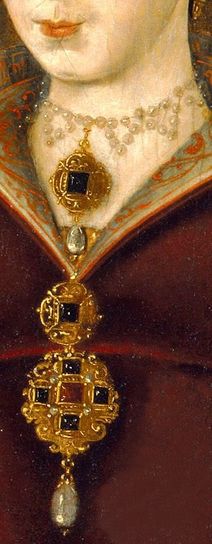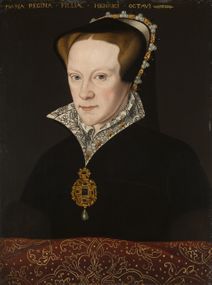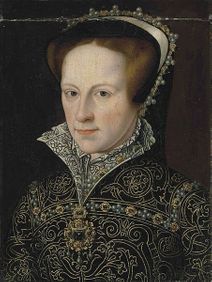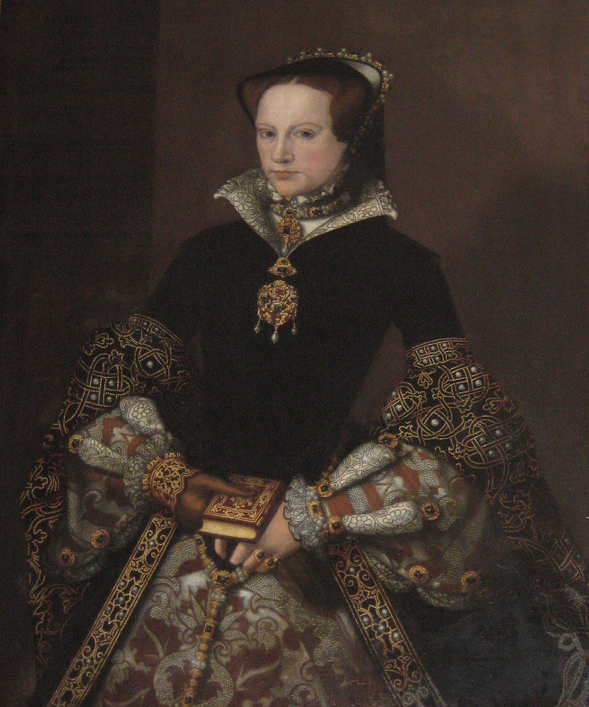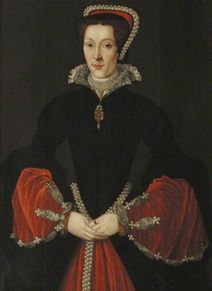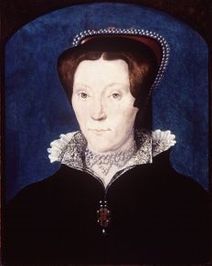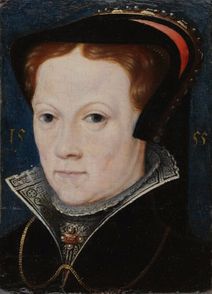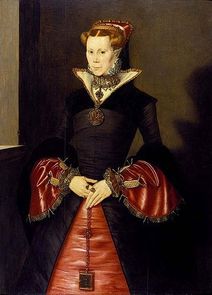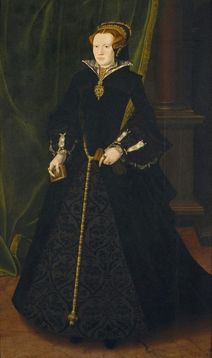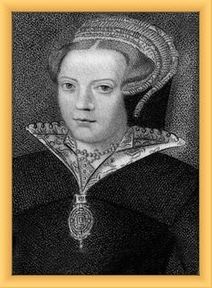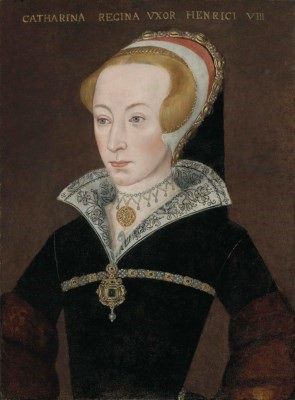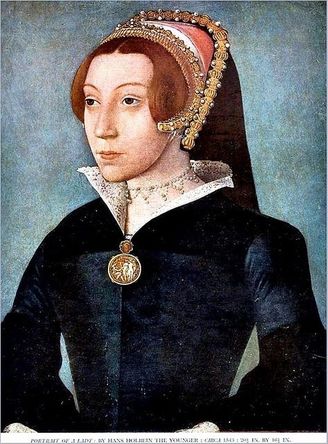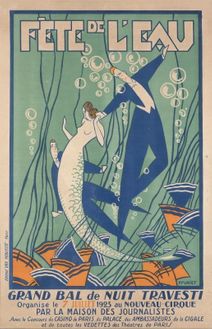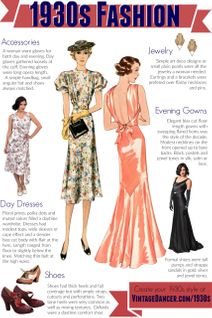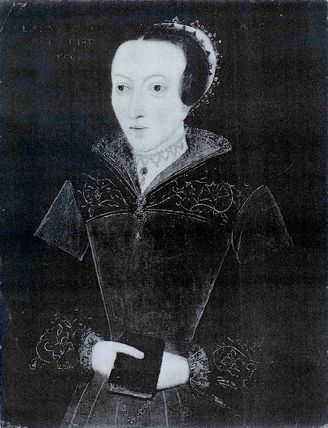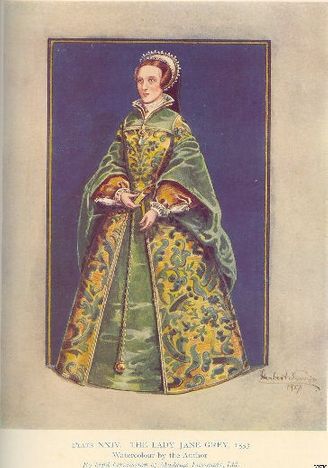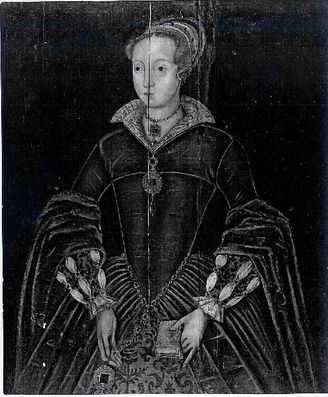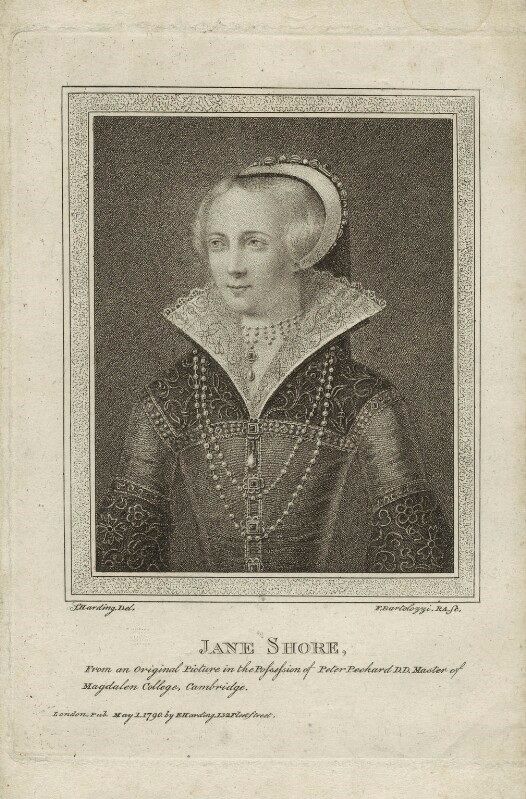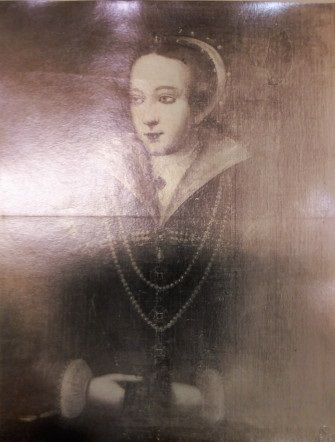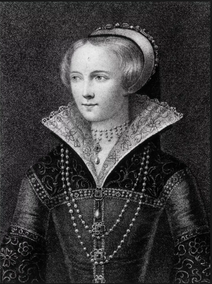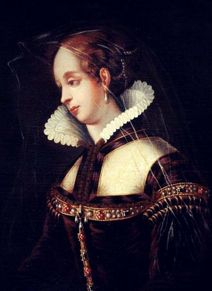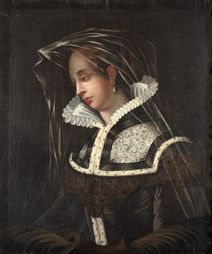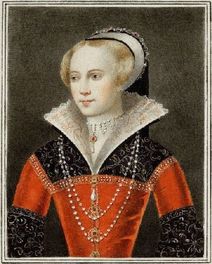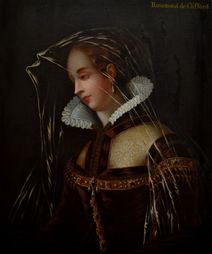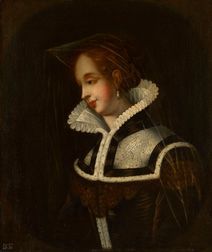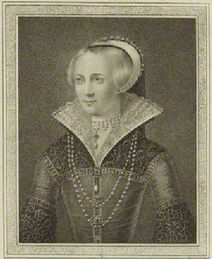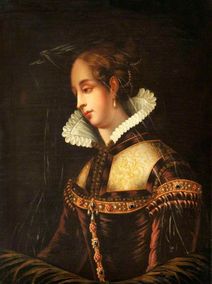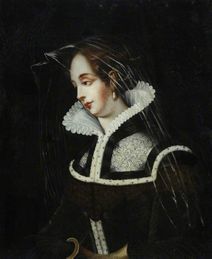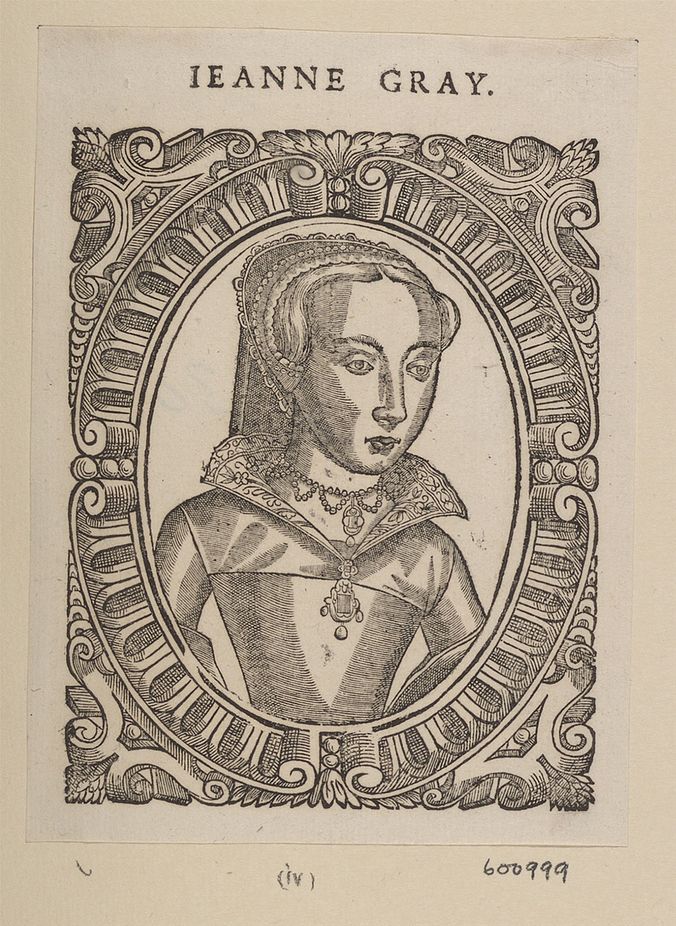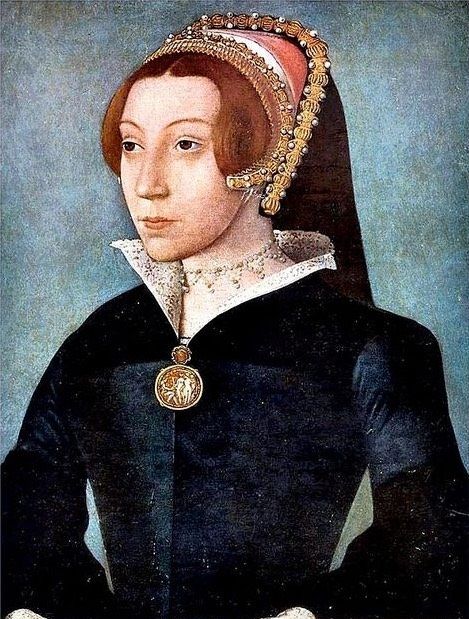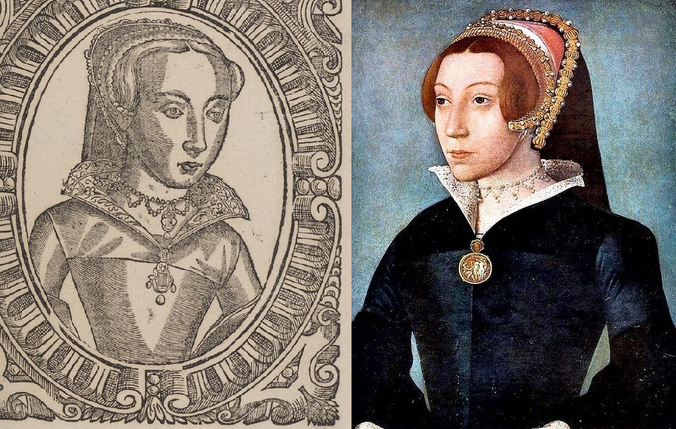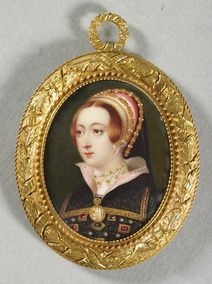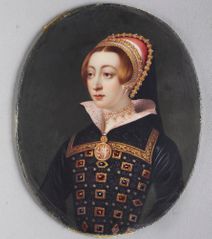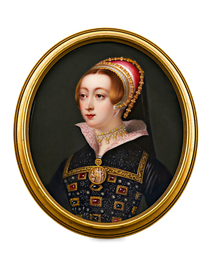The van de Passe engraving called Lady Jane Grey
Lady Jane Grey
I first became interested in this mystery because of the wonderful webside of J. Stephan Edwards at Some Grey Matter.
Before that I had been supremely uninterested in the matter, having the van de Passe engraving firmly entrenched in my mind as my image of Lady Jane Grey.
Imagine my shock when I found out that it was in actually based on a picture of Katherine Parr instead!
Similar to what many of us have gone through, I am sure. Still, it piqued my interest. Who among us, after all, can resist a good mystery?
And I must admit that bits and pieces of this theory have been floating around in my head for many years .
After reading his excellent webside, I read his equally excellent book J. Stephan Edwards: A Queen of a New Invention : Portraits of Lady Jane Grey Dudley, England's Nine Days Queen.
Most recently, my interest was revived by Lee Porritt's website: Lady Jane Grey Revisited: Iconography of Lady Jane Grey
And it was there I found the missing pieces of the puzzle.
But, let us first begin with the Streatham Portrait.
Lady Jane Grey - The Streatham Portrait
Like for many of us, the Streatham Portrait was a dreadful disappointment to me. It could not in any way replace the loveliness of the van de Passe engraving as an image of Lady Jane Grey in my heart.
The head in the portrait is practically a spool head, like one you would find on an old-fashioned fashion doll.
American Girl's Felicity's Invitation & Fashion Doll
Two things, however, struck me about the portrait.
One was the remarkable resemblance between the dress of the lady in the Streatham Portrait and the dress Mary I Tudor wears in the famous portrait of her by Anthonis Mor, and especially in the copies thereof.
The Streatham Portrait called Lady Jane Grey
Queen Mary I (Mary Tudor) (1516–1558, after Antonis Mor (Utrecht 1519 – Antwerp 1575)
A follower of Anthonis Mor, c.1555-58. This is an English copy of the famous portrait of Mary I Tudor by Anthonis Mor.
Mary Tudor, Queen of England, Second Wife of Philip II, by Anthonis Mor, 1554
Lady Jane Grey and Mary I Tudor – Great Montage by History of Royal Women
Blank space
The Streatham Portrait called Lady Jane Grey (detail)
Mary I (1516-58) c.1550-1699 After Anthonis Mor
The below painting of Mary I Tudor features a brooch nearly identical to the one in the Streatham Portrait, and she is holding a book.
The lady's head could be Mary I Tudor's. There is nothing to signify that it isn't. But there is nothing to signify that it is, either. There is nothing of Mary I Tudor's characteristic features in the face of the Streatham lady.
However, undeterred, I kept examining every copy of the famous portrait of Mary I Tudor by Anthonis Mor that I came across.
If I could find one where Mary's necklace had evolved into the scooped necklace of the Streatham Portrait, I thought, then I would have found the reference portrait, or the missing link, if you will, between a portrait that we know is of Mary I Tudor, and the Streatham Portrait.
However, of the many, many, many copies of the portrait of Mary I Tudor by Anthonis Mor that I looked at, not one had the distinctive scooped carcanet of the lady in the Streatham Portrait.
Another difference I noticed, is that in the portraits of Mary I Tudor she always has a high neckline, while the girl in the Streatham Portrait has a bare throat.
Simultaneously as I kept examining every copy of the famous painting of Mary I Tudor by Anthonis Mor I came across, I started at the other end – looking for portraits with the distinctive necklace.
Lady Elizabeth Pope, née Blount (c.1515–1593) (Trinity College, University of Oxford - Oxford, Oxfordshire UK)
Lady Elizabeth Pope, née Blount (c.1515–1593) (Trinity College, University of Oxford - Oxford, Oxfordshire UK) - Called Posthumous Painting of Mary I Tudor
Queen Mary I after Anthonis Mor – NPG 4174
The finding of this picture raised my hopes. Especially when I found what is clearly a copy of it labelled Posthumous Painting of Mary I Tudor. Perhaps the original painting had been mislabelled and was in fact a portrait Mary I Tudor?
These hopes proved to be utterly groundless when it became clear that the reason that the portrait of Lady Elizabeth Pope, née Blount (c.1515–1593) was at Trinity College at Oxford University in the first place was that her husband Thomas Pope founded Trinity College there. She was his third and last wife; he died childless. He was her second of three husbands; she also died childless. Trinity College was hardly likely to mistake the wife of their founder with Mary I Tudor.
Besides, the painting was only painted in 1612, a full twenty years after the Streatham Portrait. We can therefore safely rule it out as the reference portrait.
The mislabelling of the copy of the portrait of Lady Elizabeth Pope, née Blount (c.1515–1593) in the Eskenazi Museum of Art at Indiana University instead appears to be based on a similarity with NPG 4174.
The Fitzwilliam Portrait
Mary Dudley, Lady Sidney
Mary Dudley, Lady Sidney
With the Fitzwilliam Portrait of an Unknown Lady formerly called Mary I (perhaps Lady Jane Grey) c. 1550–55, we are in luck. The portrait has already been identified as both Queen Mary I Tudor and Lady Jane Grey, both identifications since dismissed.
Mary Dudley, Lady Sidney (c.1530-1586) – «Marks and inscriptions Lady Mary Dudley wife to Sir Henry Sidney (not contemporary but was found beneath a more modern inscription when the portrait was cleaned in 1962)» Besides, this lady is clearly too old to be Lady Jane Grey.
Katherine Parr - Philip Mould Gallery
Hans Holbein the Younger, Portrait of Elizabeth Tudor, the future Elizabeth I, Private Collection, tempera and oil on oak panel, 52 x 42 cm.
There is something sour and cross in the lady's expression in the Philip Mould Katherine Parr which does fit with our image of Mary and how she is portrayed. Any desire to replace the identification of this portrait of Katherine Parr with Mary I Tudor is, however, sadly thwarted by the fact that the painting is clearly inscribed CATHARINA REGINA VXOR HENRICI VIII. There is just no way in which that could refer to Henry VIII's daughter Mary instead. It could not even be any of his other wives named Katherine, because Katherine of Aragon and Katherine Howard had both passed away before the fashion of a square brim on the French hood had been introduced. It seems almost wrong and too late of a fashion for Katherine Parr too, and it is the only painting in which I have seen her wear one.
The second one I dismissed out of hand. It looked like a French poster, with the crayon blue background, the vintage kind. Her features were almost too regular, like the Anglesey Abbey fantasy portrait of Lady Jane Grey.
She almost didn't look like a real woman somehow, like the Anglesey Abbey Lady Jane Grey, and there was something odd about her eyes.
Much to my surprise it turned out that the lovely old print that I had fondly imagined hanging on the wall of some chic little apartment in Paris as people lounged about with evening cocktails listening to the grammophone, was an actual painting called Hans Holbein the Younger, Portrait of Elizabeth Tudor, the future Elizabeth I, Private Collection, tempera and oil on oak panel, 52 x 42 cm.
The family that owns the painting is clearly fond of it, because they have had dendrochronological testing done on it, and the panel dates to 1542.
French Vintage Poster
1930’s Fashion
The Houghton Portrait
A beautiful colour photograph of this painting can be seen p. 54 of the book A Queen of a New Invention by J. Stephan Edwards.
J.Stephan Edwards believes this painting, the Houghton Portrait, to be a direct copy of the Streatham Portrait.[1]
However, Lee Porritt raises an interesting point: «From the image this portrait appears to have been created by a different artist than that who produced the Streatham portrait, the shading and definition of the facial feature appear to be of a finer quality than that seen in the NPG copy which suggest a possible pattern used within a workshop to create multiple copies by different artists.»
So instead of a direct copy it could be a case of both portraits being created from the same pattern used within the workshop.
The Norris Portrait
The Houghton Portrait
In 1931 this painting belonged to Herbert Norris (d.1950), who had acquired the picture from an unnamed ‘friend’ who had in turn purchased the portrait from an unidentified ‘picture shop’ in 1870.[2]
It is inscribed: ‘LADYE JANE GRAY, DIED 1553 AET 17’
In his volume on Tudor costume published in 1938, The Tudors, Volume 3 of Costume and Fashion, Herbert Norris included a watercolour illustration of Lady Jane Grey, plate XXIV, that was based directly on the Norris Portrait.
Fill in later
The Dauntsey Portrait, probably the same as the Magdalene Portrait, called Jane Shore
Jane Shore – Penrhyn Castle. National Trust
Jane Shore – Chirk Castle, Wrexham, Wales, National Trust
Fair Rosamund – Priory Fine Art
Fair Rosamund – Palace of Holyroodhouse
Jane Shore – Powys Castle
Rosamund Clifford (before 1150–c.1176), Mistress of Henry II – Ferens Art Gallery
Fair Rosamund – Priory Fine Art – An extremely fine early 18th century half length portrait of Rosamund Clifford - the famous 12th century beauty and mistress of King Henry II. The painting is a wonderful example of the portraits of the 18th century English school, the subject most attractive. The painting is inscribed 'Rosamond de Clifford' upper right, the frame with a plaque lower center which again identifies the subject of the painting.
Jane Shore – Powys Castle, National Trust – "Jane Shore". 1978 listed as "Rosamund Clifford". From A Guide to the Pictures at Powis Castle by Dr Peter Moore (36) British School Jane Shore (d.1527), early 18th century. NT1180920. Jane Shore was one of the many mistresses of King Edward IV of England. Through her liaisons with the king and several other prominent courtiers she became entangled in the political intrigues that led to the usurpation of Richard III and the revival of civil war in the 1480s. As Thomas More noted in his History of King Richard III (c.1513): ‘... she delighted not men so much in her beauty as in her pleasant behaviour. For a proper wit had she, and could both read well and write, merry in company, ready and quick of answer, neither mute nor full of babble, sometimes taunting without displeasure, and not without play.’ Jane later became a recognised penitent, and in the early eighteenth century, the image of her in this guise was a popular subject. There are similar versions of this painting, from the same period, at Penrhyn Castle and Chirk Castle.
Jane Shore – Chirk Castle, Wrexham, Wales, National Trust – Jane Shore (c.1450 - 1526/7), Mistress of Edward IV – Oil painting on canvas, 'Jane Shore' (c. 1450 - c.1526/27), Mistress of Edward IV, English School, early 18th century. A half-length portrait to left, in medieval costume with high ruff collar, veil with pearl earrings, ermine trimmed dress, in hybrid costume of c. 1545-1555, looking down, transparent veil over her head, in a V-shaped ruff, embroidered panels on her upper breast; ermine edging to these and down her front. Two palm fronds emerge from the scroll of a cartouche below. Copied from a 16th century portrait; other versions in Royal Collection and Ferens Art Gallery, Hull. Other versions at Powis and Penrhyn.
Fair Rosamund – Palace of Holyroodhouse – This is a portrait painted in c. 1720 of a Romantic heroine. It was described as 'Fair Rosamond' in the Queen's Dressing Room at Kensington in 1734 and as 'Rosamond Clifford' (mistress of Henry II) in the Kensington inventory of 1818. It has also been identified as depicting Lady Jane Grey. The sitter appears in imaginary historical costume of a vaguely Tudor flavour, the collar with a narrow ermine edge. With a small pearl strand in her hair and large drop earrings. Provenance: Possibly first recorded in the Royal Collection during the reign of George II
Called Princess Elizabeth Tudor, by Hans Holbein the Younger, c. 1542
The Portrait
The portrait depicts a young woman standing before a plain blue background and facing slightly to her proper right. Her eyes are brown, and her hair is auburn. She wears her hair in the most common manner of the Tudor period, parted in the center and swept back to cover the ears. The nose is straight. On her head she wears a French hood of crimson satin with a flattened crown arch. The upper and nether billiment of the hood contain numerous small pearls set in goldwork. The lady is dressed in black gown, with what may be a black partlet across the shoulders, with a standing open collar overlaid with a white lining that is heavily embroidered with blackwork. The jewels, other than those on the French hood, consist of a festooned pearl necklace and a large brooch affixed to the upper bodice. The brooch itself appears to be a cameo picturing the Judgement of Paris.
Lady Jane Grey?
This is obviously the painting the engraving is based on.
Now, ironically, Lady Jane Grey is practically the only identity I have not seen assigned to this painting.
Henry Pierce Bone called it Anne Boleyn when he painted copies on enamel of it in 1812, 1835 and in 1843.
Alison Weir claimed that it was actually Katherine Parr in 2011.
Most recently it has been known as Elizabeth I when a Princess.
I myself have considered both Anne Boleyn and Katherine Howard as the sitter of the mysterious portrait, and rejected them both on the same grounds: The French hood is simply of a later style than either of them would live to wear.
Allow me to make the suggestion now.
This might actually be Lady Jane Grey.
Called Anne Boleyn (1507-1536). Signed and dated 1843
Called Anne Boleyn (1507-1536) Signed and dated 1835
Called Anne Boleyn (1507-1536) Signed and dated 1812
Comments
Luke Aaron
04.02.2022 18:20
Thanks for the site and the thoughts. You may enjoy(or not!) taking a look at mine: http://lukism.wordpress.com/2021/09/15/lady-jane-grey/. I agree that Jane may have had an eye irregularity. Cheers.
Mary Richards
21.02.2021 04:10
It might just be me here, but does anyone note a resemblance between the Grimsthorpe and the Streatham portraits? Is it possible that the Streatham could have been based on the Grimsthorpe model?
Site Owner
22.02.2021 14:04
For the rationale behind identifying the Streatham Portrait as Lady Jane Grey, I think one major factor was the inscription ‘Lady Jayne’.
Site Owner
22.02.2021 14:03
Much of the paint of the inscription had deteriorated, rendering the writing less than clear,
Site Owner
22.02.2021 14:03
but authorities agreed that ‘Lady Jayne’ was the likely text. Dr. Libby Sheldon of the University College of London who examined the portrait believed that the inscription was exactly contemporaneous
Site Owner
22.02.2021 14:01
with the painting itself, which dendrochronological analysis has revealed to date from no earlier than the 1590's. Another was its similarity with the Houghton Portrait (shown above).
Site Owner
22.02.2021 14:00
The Houghton Portrait originated with the Rodes family of Houghton Hall in Yorkshire and was part of a larger collection of portraits of Protestant heroes.The Houghton Portrait was displayed
Site Owner
22.02.2021 14:00
in a national exhibition in 1866 as a portrait of Jane Grey. The existence of two identical but quite separate works under the same identification suggested that the identification was authentic.
Site Owner
22.02.2021 13:58
Wikipedia has a bit more information: https://en.wikipedia.org/wiki/Streatham_portrait
Site Owner
22.02.2021 13:57
And J. Stephan Edwards writes of both portraits on p. 50-58 of his book A Queen of A New Invention.
Site Owner
22.02.2021 13:57
It is such a shame. I too would love it if they did a complete examination of this portrait. From being a rather obscure
Site Owner
22.02.2021 13:56
and inauspicious painting I have grown very fond of it. I think that this is actually Lady Jane Grey. So much more the shame that is was overpainted.
Site Owner
22.02.2021 13:54
Again we are in complete agreement. It makes no sense to me either why they would "mix & match" backgrounds, jewellery etc., however, clearly there is a precedent of sorts for it.
Site Owner
22.02.2021 13:53
In addition to the portrait with the head of Mary I Tudor above, but with the dress and jewellery of Katherine Parr, there is also the fact that when it cames to portrait sets you will often see
Site Owner
22.02.2021 13:52
that the painters have 'borrowed' jewellery from one lady to give to another. In the portrait I have posted of Jane Seymour above, she too is wearing Mary I Tudor's famous brooch.
Mary Richards
22.02.2021 11:55
Out of interest, would you happen to know what the NPG's rationale was for identifying the Streatham as Jane? It could aid with the identification of the Grimsthorpe.
Mary Richards
22.02.2021 11:54
It is a shame that the Grimsthorpe portrait has been painted over. It would be fascinating to see what the sitter looked like under the X-ray.
Mary Richards
22.02.2021 11:52
It makes no sense to me why they would "mix & match" backgrounds, jewellery etc however I think there is a precedent of sorts for it.
Site Owner
22.02.2021 11:04
You are definitely not the only one to notice the resemblance between the Grimsthorpe and the Streatham Portrait! I entirely agree.
Site Owner
22.02.2021 11:03
I too have wondered if the Streatham Portrait is based on the Grimsthorpe Portrait.
Site Owner
22.02.2021 11:03
The only problem is that all of the particular traits of the Streatham Portrait, the carcanet from the Duckett Portrait,
Site Owner
22.02.2021 11:02
the jewellery from the engraving and the portraits of Mary I Tudor, and Mary I
Tudor's dress cannot be found in the Grimsthorpe Portrait.
Site Owner
22.02.2021 11:01
While the brooch the lady is wearing in the Grimsthorpe Portrait (and the Duckett
Portrait) cannot be found in the Streatham Portrait.
Site Owner
22.02.2021 11:00
Also, if the copyists had access to a full-length gown, we did they feel the need to superimpose the dress of Mary I Tudor onto the image?
Site Owner
22.02.2021 10:59
Since then, however, I have come over a painting of Mary I Tudor, in Katherine Parr's
dress and jewellery, with the background of Elizabeth when a Princess.
Site Owner
22.02.2021 10:58
I have now posted this painting above. This painting does look 'younger' than the Streatham Portrait, but even so I feel that it sets a 'precedent' of sorts. That would however mean that the creator
Site Owner
22.02.2021 10:57
had access to both the engraving or the Duckett Portrait or some version thereof with the carcanet necklace and the Grimsthorpe Portrait 😊
Isabella Quigley Moriarty
25.04.2020 11:02
I just want to say thank you for your generosity in creating and maintaining varying and your own points of view on these portraits and stories. As an avid reader of history/herstory I appreciate it.
Site Owner
27.04.2020 19:58
Oh, thank you so much! What a lovely comment to receive! This site has given me a lot of pleasure, and it is so lovely to hear that that is the case for somebody else too :)
Latest comments
07.12 | 21:47
It looks like The Tau cross derives from the Egyptian Ankh and basically they are wearing it around their necks, life rebirth, salvation mirror. sun.Stonehenge looks like it is made up of Ts to form c
07.12 | 21:30
are wearing the symbol on effigies at Ingham church Norfolk and Henry StanleyD1528 at Hillingdon Middlesex.Countess Jacquline of Hainaut and husband Frank Borsele are also wearing the insignia others
07.12 | 21:23
These Queens could of been members of the order and i think the Tau cross is a symbol of the Holy Trinity also.These pendants could of been reliquaries.Lady margaret de Bois and Roger de bois
07.12 | 21:17
I think the Tau cross that they are wearing could be linked to the(knights) order of St Anthony, Mary 1st collar looks like it may represent the knotted girdle/waist cord of st Anthony .
Share this page
